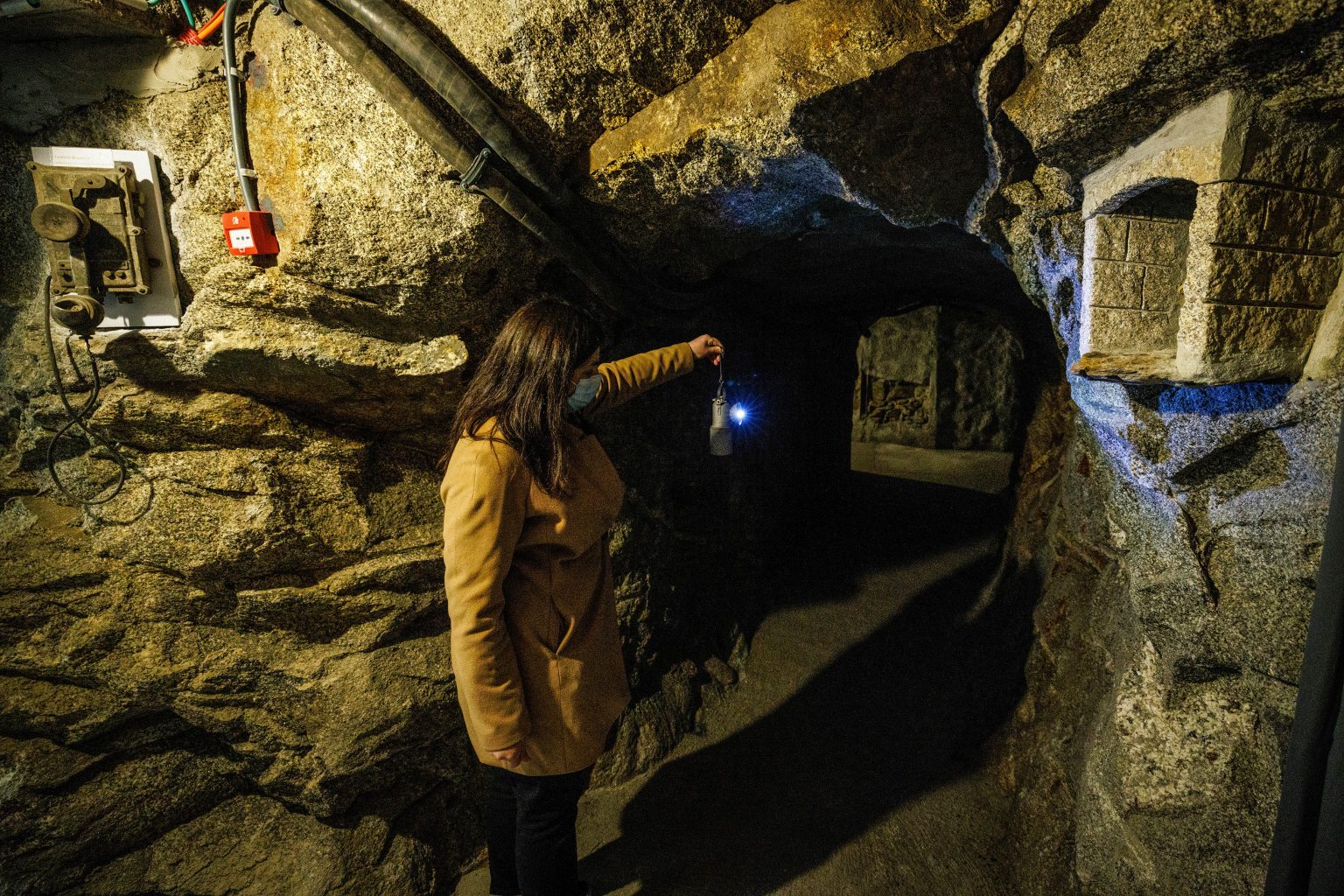Former miner in Jales, César Almeida shared objects and memories to help create the interpretive center that opens its doors on Saturday, in Vila Pouca de Aguiar, and honors the last exploration of gold in Portugal.
There, visitors will be able to descend into a mining tunnel, a 110-meter circular underground replica, to discover what it is like to be inside a mine and understand how the hard work of miners was done.
The Jales Mining Interpretive Center will be inaugurated on Saturday in Campo de Jales, Vila Pouca de Aguiar, where gold and silver were explored for 60 years until the mine was closed in 1992.
The museological space was born in the old hoist house of the Santa Bárbara shaft, which allowed the vertical transport of miners to the tunnels. The mining activity was developed along about five kilometers and reached 630 meters.
César Macedo de Almeida had to work three years on the surface until he reached 18, the permitted age to enter the mine. Now 66 years old, the former miner told Lusa news agency that he used to maintain the machines, such as pumps, mechanical shovels, locomotives, or winches.
“It was a bit complicated to work inside there, but it was a very safe mine,” he stressed.
He says he knew the whole mine “from the bottom to the top.” “I would go to the fronts to the sledgehammer if I needed to set up the mechanical shovel; I was there for eight hours a day,” he stated.
He left Campo de Jales in 1990, when he was already a department head in the workshop, to go work for “the same boss,” but in São João da Madeira (Aveiro). He returned 17 years later to his hometown, where he lives, now that he is retired.
“In my father’s time, there were more than 800 workers, not counting the families. When I left, there were only about 150. The mine worked in three shifts, and about 30 kilos of gold were extracted from there every month,” he said.
The village “had everything,” such as a medical center, pharmacy, and a dining hall. “It was a good company. It provided housing for some of the workers, paid for electricity, gas, and gave firewood,” said the former miner.
The Jales mines were “the economic engine” of this region of the Vila Real district, which, was hit by unemployment and depopulation after the closure.
César Macedo de Almeida believes that in Jales, “there is still a lot of gold” to be explored. Not in the old mine, but in the vicinity, only that, he pointed out, “the right man hasn’t arrived here yet” to do it.
From the mine, he kept stories and also equipment, like his helmet and the gasometer he used to illuminate the gallery, documents, and some stones. These are memories and assets that he and other former miners from Jales have shared with the interpretive center.
” There is a good piece of work here, very beautiful”” he pointed out.
The mayor of Vila Pouca de Aguiar, Alberto Machado, said that the goal of the museum space was precisely to “preserve the memory of the miners of Jales and, in this way, rescue the mining tradition in this region.“
To realize the project, the Association for Integrated Development of the Lands of Jales (AOURO) submitted an application, supported by the municipality, to the Valorizar program of the Tourism of Portugal. The investment was about 600 thousand euros.
Outside, one can see the old trestle of the Santa Bárbara pit, where the workers and equipment descended to the galleries. In the building next door, which has been transformed into a museum and where the engine that made the elevator work was installed, a map of the mine has been placed, where one can see the 16 levels on which the mining operation was developed.
Inside, the museum consists of three floors: upper, ground, and lower, the latter being a replica of an underground gallery with access identical to that used by the miners.
Patrícia Machado, an archaeologist of the municipality, explained to Lusa that the project wanted to””document in historical terms the concession that lasted about 60 years, between the’30ss and the90’s”” of the last century.
“And, on the other hand, pay tribute to the miners and the people who, in one way or another, ended up preserving spoils and some documentation related to the time they worked in the mines”” she added.
The replica allows visitors to have the experience of being inside a mining gallery. The tunnel starts with a wooden lining, identical to the one originally used in the mine, and ends with another, more modern one made of shotcrete.
Along the tunnel, the tools used by the miners were placed and it is also possible to see, through a window, the elevator shaft that goes down 630 meters, an old telephone, and theminers” patron saint, Santa Bárbara.
Patrícia Machado mentioned that the museum also shows the different professions of those who worked inside the mine, from the”“marteleir””, the”“amostrado””, and the”“entivado”” (who shored up the mine). The women were the task workers, who did jobs around the mine, including placing explosives into the candles that were used in the exploration.
In Jales, after the openimine’sthe interpretive center, the mine’s siren will sound daily at 12:00.
Artigo em Português
Antigos mineiros homenageados em Jales, a última mina de ouro em Portugal
Vila Pouca de Aguiar, Vila Real, 17 fev 2022 (Lusa) – Antigo mineiro em Jales, César Almeida partilhou peças e memórias para ajudar a erguer o centro interpretativo que abre portas no sábado, em Vila Pouca de Aguiar, e homenageia os trabalhadores da última exploração de ouro em Portugal.
Ali, os visitantes vão poder descer a uma galeria mineira, uma réplica subterrânea de 110 metros e de formato circular, para descobrir o que é estar dentro de uma mina e perceber como era feito o trabalho duro dos mineiros.
O Centro Interpretativo Mineiro de Jales vai ser inaugurado no sábado, em Campo de Jales, em Vila Pouca de Aguiar, onde ao longo de 60 anos se explorou ouro e prata, até ao encerramento da mina em 1992.
O espaço museológico nasceu na antiga casa do guincho do poço de Santa Bárbara, que permitia o transporte vertical de mineiros até às galerias. A atividade mineira desenvolveu-se ao longo de cerca de cinco quilómetros e atingiu os 630 metros de profundidade.
César Macedo de Almeida teve de trabalhar três anos à superfície até atingir os 18 anos, a idade permitida para entrar na mina. O antigo mineiro, agora com 66 anos, contou à agência Lusa que fazia a manutenção às máquinas, como bombas, pás mecânicas, locomotivas ou guinchos.
“Era um bocado complicado trabalhar lá dentro, mas era uma mina muito segura”, salientou.
Diz que conhecia a mina toda “de baixo acima”. “Ia às frentes ter com o marteleiro se fosse preciso compor a pá mecânica, andava lá oito horas por dia”, referiu.
Saiu de Campo de Jales em 1990, quando já era chefe de secção na oficina, para ir trabalhar para o “mesmo patrão”, mas em São João da Madeira (Aveiro). Regressou 17 anos depois para a terra natal onde vive, agora reformado.
“No tempo do meu pai havia mais de 800 trabalhadores, fora as famílias. Quando eu fui embora já só havia para aí uns 150. A mina trabalhava por três turnos e dali eram retirados cerca de 30 quilos de ouro por mês”, referiu.
A aldeia “tinha de tudo”, como um posto médico, farmácia, refeitório. “Era uma boa empresa, dava casa a alguns trabalhadores, pagava luz, gás, dava lenha”, referiu o antigo mineiro.
As minas de Jales eram “o motor económico” desta região do distrito de Vila Real que, depois do encerramento, foi atingida pelo desemprego e o despovoamento.
César Macedo de Almeida acredita que em Jales “ainda há muito ouro” por explorar. Não na antiga mina, mas nas imediações, só que, apontou, “ainda não chegou aqui o homem certo” para o fazer.
Da mina guardou histórias e também equipamentos, como o capacete e o gasómetro com que iluminava a galeria, documentos e algumas pedras. São memórias e espólio que ele e outros antigos mineiros de Jales partilharam com o centro interpretativo.
“Está aqui uma boa obra, muito bonita”, salientou.
O presidente da Câmara de Vila Pouca de Aguiar, Alberto Machado, afirmou que o objetivo do espaço museológico foi precisamente “preservar a memória dos mineiros de Jales e, desta forma, resgatar a tradição mineira nesta região”.
Para a concretização do projeto, a Associação de Desenvolvimento Integrado das Terras de Jales (AOURO) apresentou uma candidatura, apoiada pelo município, ao programa Valorizar do Turismo de Portugal. O investimento foi de cerca de 600 mil euros.
No exterior é possível observar o antigo cavalete do poço de Santa Bárbara, por onde os trabalhadores e o equipamento desciam às galerias, e, no edifício ao lado, transformado em museu e onde estava instalado o motor que fazia funcionar o elevador, foi colocado um mapa da mina, onde se veem os 16 patamares em que se foi desenvolvendo a exploração mineira.
No interior, o espaço museológico é constituído por três pisos: superior, térreo e inferior, sendo este uma réplica de galeria subterrânea com acesso idêntico ao utilizado pelos mineiros.
Patrícia Machado, arqueóloga do município, explicou à Lusa que o projeto quis “documentar em termos históricos a concessão que durou cerca de 60 anos, entre as décadas de 30 e a de 90” do século passado.
“E, por outro lado, homenagear os mineiros e as pessoas que, de uma maneira ou de outra, acabaram por preservar espólio e alguma documentação relacionada com o tempo em que trabalharam nas minas”, acrescentou.
A réplica permite aos visitantes ter a experiência de estar dentro de uma galeria mineira. O túnel começa com um revestimento de madeira, idêntico ao usado inicialmente na mina e acaba com outro, mais moderno, de betão projetado.
Ao longo do túnel foram colocadas as ferramentas usadas pelos mineiros e é também possível observar, através de uma janela, o poço do elevador que desce 630 metros, um telefone antigo e a padroeira dos mineiros, Santa Bárbara.
Patrícia Machado referiu que ali são também dadas a conhecer as diferentes profissões de quem trabalhava dentro da mina, desde o marteleiro, o amostrador, o entivador (fazia o escoramento da mina). As mulheres eram as tarefeiras, faziam trabalhos em torno da mina, incluindo a colocação de explosivos dentro das velas que eram usadas na exploração.
Em Jales, depois da abertura do centro interpretativo a sirene da mina tocará diariamente às 12:00.


